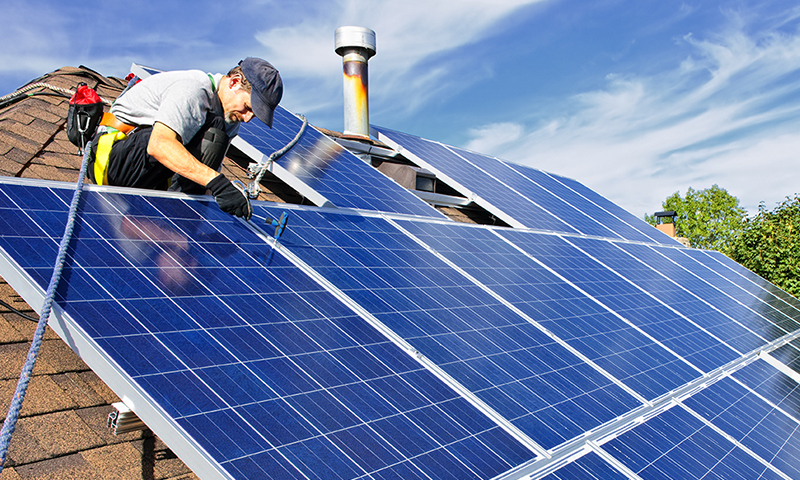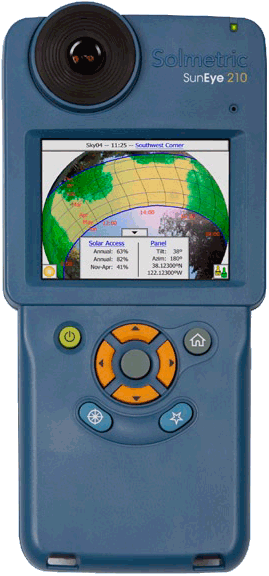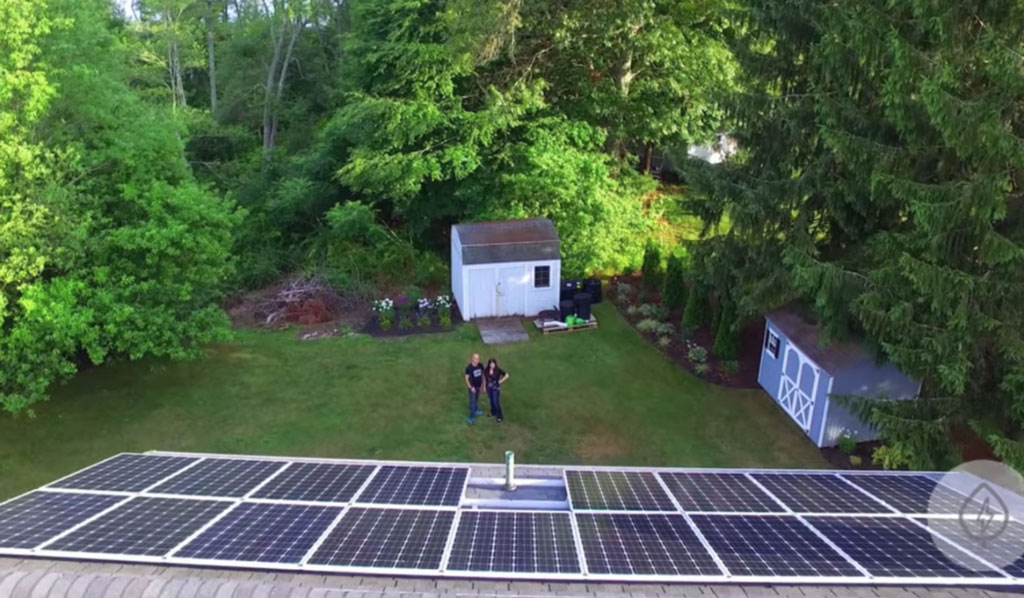Shading Analysis: How To Do It And Get It Right

Inaccuracy in shade reports is all too common.
If you put ten different people up on the same roof with the same handheld shading analysis device or behind the controls of a do-it-yourself (DIY) software platform, you’ll most likely end up with ten different results. And these inaccurate shade reports often cause many problems for contractors and customers alike.
After all, the amount of shade on a roof directly affects the electric production capacity of a system, which in turn affects everything from the type of equipment you should order to the consumer’s return on investment.
If you didn’t even realize this was an issue, you’re not alone. Handheld devices have been the go-to in the industry for so long that many contractors haven’t given it a second thought. Many solar design software providers tout shading accuracy, with the unspoken caveat that the accuracy is dependent on the user, but a shade analysis can actually make or break you. Especially as competition in the solar industry becomes more and more fierce.
So we’re going to touch on a few issues related to shading analysis to help you wrap your head around the big picture. Here’s what we’ll look at in this article:
- Is accuracy all that important when doing a shading analysis?
- The real cost of an inaccurate shading analysis
- Major benefits of an accurate shading analysis
- Different tools for the job
- Best practices to reduce shading loss
- Impact of shading analysis on your customers
Let’s get started.
Is accuracy all that important in a shading analysis?
Short answer: YES.
Accuracy is of the utmost importance. The amount of sunlight that reaches a roof is directly correlated to the financial feasibility of a system.
Longer, more detailed answer: Depending on the solar project location or how the project is funded, the market has varying impressions on whether the shading analysis needs to be accurate. For example, certain state programs and financiers have specific requirements for the method used to calculate shade and often set minimum thresholds of shade for project viability.
On the residential side, however, there is no “standard” to be measured against. The industry has certain methods of estimating shade that are accepted, but the accuracy of each is difficult to quantify, leaving no real source of truth to compare it to.
Also on the residential side, there’s a misconception that shading accuracy only matters if you’re offering a performance guarantee or Power Purchase Agreement (PPA). But an incorrect electricity production estimate affects the homeowner’s ROI and satisfaction as a customer — whether there’s a guarantee or not. And consumer protection has become a hot topic in solar, as many homeowners were sold or promised savings that didn’t pan out.
So, even though shading analysis accuracy isn’t required in all parts of the solar industry yet, it’s certainly important. This brings us to the next issue… The cost of inaccuracy.
The real cost of inaccurate solar panel shading analysis
The impact of shade is probably the largest loss when it comes to estimating the electricity production of a solar PV system. (Other factors include things like location, weather, equipment, and roof plane direction.)
So if your analysis isn’t accurate, you’ll likely end up with a big mismatch between the estimated production you promised the consumer and the actual production given the amount of shade on the roof. As we mentioned above, this has a major impact on the consumer.
But it also affects contractors. There are many hidden costs associated with inaccurate shading analysis that directly affect your profitability and long-term success in the industry. Namely, increased customer acquisition costs due to poor customer experience and low referral rates and increased labor and operational costs due to change orders and high cancellation rates.
Major benefits of accurate shading analysis
As you’re probably picking up by now, one of the main benefits of an accurate shading analysis is that it improves the accuracy of your estimated electricity production. But there’s more… Here are five major benefits of doing an accurate shading analysis.
1. Leads to better overall solar energy system design
Accurate shade estimation tools provide precise calculations like Solar Access Values (SAV) and Total Solar Resource Fraction (TSRF) that are derived from high-resolution aerial imagery. These data points help designers determine the optimal placement of solar panels within solar PV systems to maximize energy production.
2. Improves financial modeling
An accurate shading analysis allows you to create accurate financial models based on the estimated production capacity of the system. This can help close deals and improve customer satisfaction since financial savings is one of the top reasons consumers decide to install solar panels in the first place.
3. Informs better equipment selection
Since an accurate shading analysis leads to better overall system design, it also leads to better equipment selection in terms of both solar efficiency and cost. Specifically, it can reduce hard costs like the price or quantity of equipment used. But it can also reduce soft costs by streamlining the ordering process and getting things right the first time.
4. Increases customer satisfaction and referrals
Many customers install solar panels in order to reduce their electric bill. If your systems deliver on that expectation, you’ll likely have happy customers. This typically leads to an influx of referrals, dramatically reducing your customer acquisition costs.
5. Adds another layer of consumer protection
Unfortunately, there’s no standard unit of measure for shade when it comes to residential systems. And many user-operated tools produce variable results — a combination that leaves consumers in a tricky spot. An accurate shade analysis that relies on a 3rd party source of truth, however, protects consumers from both dishonest vendors and honest, but inaccurate estimates.
Types of tools for performing a solar shading analysis
Now that you know how much an accurate shading analysis can benefit your business, here are a few types of tools that can be used to estimate shade on the roof surface.
Tool category #1: Handheld devices
Handheld devices have long been considered the go-to tool in the industry when it comes to estimating shade. An example is the Solmetric using 210, which measures the available solar energy per day, month, and year by determining the shading patterns of a particular site.

The downside to using a handheld device like the SunEye though is that it’s only as good as the operator. And this leaves you and the consumer vulnerable to user error and the subjective nature of the results.
Tool category #2: DIY solar software
Tools in this category estimate shade by creating 3D models based on satellite or aerial imagery and sometimes LiDAR as a reference.
Some DIY solar software tools can be very good but the results they provide are based on the user operating the software. The user’s interpretation and skill level will impact the results and vary from user to user.
Tool category #3: Aerial imagery
Tools that estimate shade based on aerial imagery are the most accurate. EagleView’s Inform Advanced solution was launched in 2019 and it calculates shade using 3D data derived from high-resolution aerial imagery.

One of the main benefits to using this type of tool is that the user can’t affect the results at all, intentionally or unintentionally — making EagleView Inform Advanced a third-party source of truth, vetted by the leading global quality assurance advisor DNV-GL.
Inform Advanced uses a digital surface model that represents structures and vegetation 100 – 300 meters from the home, taking a reading every 6 inches on a roof for every 15 min throughout the year.
This generates 5,000 – 20,000 data points per roof — a level of detail that simply can’t be replicated by a human.
As DNV-GL puts it: “EagleView Inform Advanced can provide modeled solar access values at more locations on a roof than could be practically measured and processed manually.”
Inform Advanced is adding new coverage areas daily. Check out this interactive map to see if it’s available in your area.
Tool category #4: Drones
Drones offer the same quality and consistency as Inform Advanced when it comes to performing a shade analysis. However, using a drone requires scheduling an external site visit (which could be limited by weather conditions), acquisition and maintenance of equipment, user training, and dealing with other complications related to operating the drone
Best practices to properly account for shade
In this section, we’re going to go over a few best practices when it comes to shade analysis.
1. Reduce human error as much as possible
At this point, you know the mantra: most shade estimation tools are only as good as the operator. To mitigate this issue, you have two main options: switch tools or religiously train your operators. The difference between the two is that training your operators can reduce human error while a good tool can completely eliminate it. (Think: EagleView Inform Advanced)
2. The more data points, the better
When estimating the amount of shade on a roof, there are a lot of things you need to take into consideration, including roof obstructions, nearby buildings, trees and vegetation, seasonal changes, weather patterns, and more. So the more information you can gather, the more accurate your estimation will be.
Traditionally, when inspectors climb a roof with a handheld shade calculation device, they collect data from 15 to 30 measurement points. By comparison, EagleView’s solution collects 10,000 – 30,000 data points per roof, providing much more accurate results.
3. Consider all sources of shade
No amount of shade is too small to affect electrical production. In fact, Stanford University’s Gil Masters demonstrates in his book, Renewable Energy and Efficient Electric Power Systems, that shading on just one out of 36 cells in a small solar module can reduce power output by over 75%.
With this in mind, it’s important to note that shade comes from many different sources. Some are obvious, like nearby trees and buildings, while others are less obvious, like elevations in the distance. Plus, many forms of shade aren’t properly accounted for with DIY software so it’s a good idea to check your analysis to make sure it’s catching everything.
4. Set standards to maintain consistency in measurement
Besides human error, one of the biggest issues with handheld devices is subjectivity. For example, if given the same set of SunEye data, designers can choose which images are used to produce solar access percentages and if and how individual SunEyes are corrected to adjust for the auto-fill of shaded areas. So, setting standards to maintain consistency among users will help to reduce shading loss due to subjectivity.
Wrapping up: understand the impact of shading analysis accuracy on your customers
After solar tax credits, the cost for a solar panel system on an average-size house in the U.S. ranges from $11,144 to $14,696. This is no small thing for most consumers, many of whom finance the project and depend on energy savings to offset their loan payments.

So if their system doesn’t produce the amount of electricity expected due to an inaccurate shading analysis, the energy savings may not be enough to offset the loan — putting many consumers in a bad financial position.
As you can imagine, this doesn’t inspire a lot of confidence in your company from the customer’s perspective. In fact, many customers feel swindled when this happens, leading to irate phone calls, negative reviews or word-of-mouth, and even lawsuits.
On the flip side, if a system produces electricity as expected (or even more so), customers will be giddy with excitement as they watch their gamble pay off, likely referring your company to family, friends, and neighbors.
So even though the industry doesn’t require you to meet any standards with your shading analysis, it’s important to understand that it has an outsized impact on your customers, which in turn impacts your credibility in the solar installation business.
Shading analysis FAQs
Still have a few questions about shading analysis? Here are some answers to frequently asked questions.
What is shading on solar panels?
Shading on solar panels is caused by objects that prevent sunlight from reaching the solar cell, casting shade on the solar PV panels instead. This can come from nearby buildings, trees or vegetation, obstructions on the roof, or even other solar panels in the solar PV array if they’re placed too close together in a flat roof installation scenario.
How do you calculate solar shading?
Solar shading can be calculated in a number of ways. You can use handheld devices on the roof itself, DIY solar software, drones, or solutions like EagleView Inform Advanced that can calculate it based on high-resolution aerial imagery.
What happens if one solar panel is shaded?
Even if just one solar panel is shaded, the electricity production of the system can be greatly diminished. The actual impact of shade will depend greatly on the PV equipment being installed. If you recall, if just one solar cell out of 36 in a small solar module is shaded, it can reduce power output from the solar PV panels by up to 75%.

